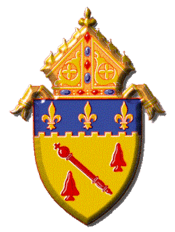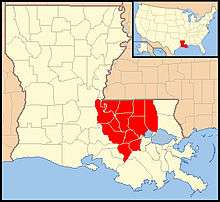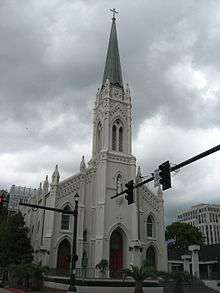Roman Catholic Diocese of Baton Rouge
| Diocese of Baton Rouge Dioecesis Rubribaculensis | |
|---|---|
 | |
| Location | |
| Country | United States |
| Territory | Parishes of Ascension, Assumption, East Baton Rouge, East Feliciana, Iberville, Livingston, Pointe Coupée, Tangipahoa, St. Helena, St. James, West Baton Rouge and West Feliciana |
| Ecclesiastical province | Archdiocese of New Orleans |
| Statistics | |
| Area | 5,513 sq mi (14,280 km2) |
| Population - Total - Catholics |
(as of 2012) 950,000 235,000 (24.7%) |
| Parishes | 68 |
| Information | |
| Denomination | Roman Catholic |
| Rite | Roman Rite |
| Established | July 20, 1961 |
| Cathedral | St. Joseph Cathedral |
| Patron saint | St. Joseph |
| Current leadership | |
| Pope | Francis |
| Bishop |
Robert William Muench Bishop of Baton Rouge |
| Metropolitan Archbishop |
Gregory Michael Aymond Archbishop of New Orleans |
| Vicar General |
Thomas Ranzino Vicar General |
| Map | |
 | |
| Website | |
| diobr.org | |
The Roman Catholic Diocese of Baton Rouge, officially in Latin Dioecesis Rubribaculensis, is a Latin Rite diocese of the Roman Catholic Church in Baton Rouge, Louisiana. It is a suffragan of the Archdiocese of New Orleans.
The diocese consists of 68 parishes, 2 ethnic apostolates, and 2 University chaplaincies.[1] Its territory comprises an area of 5,513 square miles (14,280 km2), being composed of twelve civil parishes in south central Louisiana: Ascension, Assumption, East Baton Rouge, East Feliciana, Iberville, Livingston, Pointe Coupée, Tangipahoa, St. Helena, St. James, West Baton Rouge and West Feliciana.
The current bishop is Robert William Muench. There are 106 total priests in the Diocese (71 diocesan priests of which 50 are active and 21 are inactive, 30 religious priests of which 24 are active and 6 are inactive, and 5 extern priests), 70 permanent deacons, 3 transitional deacons, 16 lay male religious (brothers), 90 female religious (nuns and sisters), and 17 seminarians.[2] The Catholic population is 215,298 out of a total population of 884,650 (24.3% of the population).
Bishops
The list of ordinaries of the diocese and their years of service:
- Robert Emmet Tracy (1961 - 1974)
- Joseph Vincent Sullivan (1974 - 1982)
- Stanley Joseph Ott (1983 - 1992)
- Alfred Clifton Hughes (1993 - 2001)
- Robert William Muench (2002–present)
Diocesan History

The Christian history of the Diocese of Baton Rouge began with the work of French missionaries among the Native American peoples of the area. In particular, French Jesuits and Capuchin Franciscans were responsible for the preaching of the Gospel along the Mississippi River during the first half of the 18th century: it is recorded that Père Pierre Charlevoix, S.J., celebrated the first Eucharist in Baton Rouge on New Year's Day, 1722, on the present site of the Louisiana State Capitol building. As permanent settlements were established in the Louisiana colony, churches were erected. The first permanent church in the region was St. Francis Chapel of Pointe Coupée, built in 1738.[3] Parishes were established at St. James in 1767, at St. Gabriel in 1769, at Donaldsonville in 1772, at Baton Rouge in 1792, and at Plattenville in 1793.
In 1793, the Diocese of New Orleans was established, but an acute shortage of clergy remained a problem for many, many years. The settlement of Baton Rouge was fortunate in that a resident priest was stationed at Our Lady of Sorrows (later St. Joseph) Parish for most of its first century. Many difficulties were encountered during the 1800s, including not only the universal problems of disease, Civil War and Reconstruction, but also sometimes violent ecclesiastical disputes over the legal authority of parochial "trustees." Still, the faith prospered and the institutional Church grew along with it, with Catholic houses of worship and education established during this time throughout the area.
The first half of the 20th century saw unprecedented growth: the rise of the City of Baton Rouge in industrial, political, and social importance meant a large population increase. The Church in the metropolitan area grew from one Parish in 1900 to nine by 1950 and to fifteen by 1960. In the larger, rural areas of the Diocese, Parishes gradually developed from "mission" chapels as resident priests began to be available.
In the bull "Peramplum Novae Aureliae" issued July 22, 1961, Pope John XXIII established the Diocese of Baton Rouge, separating it from the territory of the Archdiocese of New Orleans. The Pope named St. Joseph Church in the See city, built in 1853-1855 and renovated many times since, to be the new diocese's Cathedral. A census conducted in the very first year of the diocese's operation revealed its membership then as being 164,476 Catholics (out of the total of 464,904 people reported by the U.S. Census Bureau that year).
The first Bishop of Baton Rouge, Robert E. Tracy of New Orleans, Louisiana, energetically organized the Diocese in the spirit of Vatican Council II, of which he was a proud participant. The Church of Baton Rouge became a model for other Dioceses in establishing its post-Conciliar administrative structure and consultative process as its pastoral growth continued unabated. A younger-than-average presbyterate proved to be an enormous asset in providing unified pastoral leadership to the local Church in its formative period. Particular emphasis was placed upon liturgical renewal and modern catechetical efforts during this time.
In 1974, Joseph V. Sullivan of Kansas City, Missouri, became Baton Rouge's second bishop. His concern for Catholic education and for a more traditional approach to Catholic doctrine and practice marked his episcopal ministry in the Diocese. He was a prominent advocate of the "Pro-Life Movement," and frequently restated the opposition of the Church to abortion, euthanasia, and related evils.
In 1983 one of the original priests of the Diocese, Bishop Stanley Joseph Ott, was named the third Bishop of Baton Rouge. Under his leadership, the local Church devoted itself to a widespread effort at evangelization and spiritual renewal. He called for the laity of the Diocese, especially, to take new initiatives to renew their faith and proclaim the Good News of Jesus Christ to the world. A comprehensive program urging financial, ministerial, and spiritual stewardship was begun and for this the Church of Baton Rouge again became a model for other dioceses in North America. The Rite of Christian Initiation of Adults was put in place as a model for evangelization and catechetics. Ecumenical efforts were significant, resulting in notable efforts at interfaith sharing of prayer and some limited ministry. In 1991, however, Bishop Ott was diagnosed with inoperable liver cancer. Yet over the next 18 months, he gave eloquent witness to Gospel values by his manner of ministry, life, and dying. He became a source and focus of unity and grace to Catholics and non-Catholics alike.
In November 1993 Bishop Alfred C. Hughes of Boston, Massachusetts, was installed as Baton Rouge's fourth bishop. He continued to emphasize spiritual growth for the Catholic people of the diocese, especially by active social justice programs and deeper doctrinal formation in accord with the Catechism of the Catholic Church. He called courageously for fidelity to the Church and to her teachings in confronting the secularism of the modern world. He re-organized diocesan programs of vocations-recruitment and began a comprehensive process designed to cope with declining numbers of ordained ministers in local parishes. A major capital fundraising campaign, designed to achieve certain specific objectives and focus attention on the need for the Church to face the future with confidence and faith, was overwhelmingly successful. In February 2001 Bishop Hughes was transferred to New Orleans to be its Coadjutor Archbishop, eventually becoming the Metropolitan Archbishop there in January 2002.
Present Bishop
On December 15, 2001, the transfer of Bishop Robert William Muench of Covington, Kentucky, to the See of Baton Rouge was announced. Bishop Muench, who grew up in Louisiana and served for 28 years as a priest of the Archdiocese of New Orleans, was installed on March 14, 2002, as the fifth bishop of Baton Rouge.
Since the day he was installed, Bishop Muench has paid special attention to the Church's ministry to young people. In addition to his presiding over the parish celebrations of the sacrament of confirmation whenever possible, he has appointed chaplains at all eight Catholic high schools in the Diocese of Baton Rouge. He regularly visits each high school, spending the day in conversation - invariably with his infectious laughter! - with the students and faculty on campus. He has insisted that the Diocese of Baton Rouge remain a leader in the effort to end the evil of child abuse and provide a safe environment for all children and young people, especially within the structures of the Church. He has taken special interest in providing additional opportunities for the Sacrament of Reconciliation in Catholic high schools and in promoting vocations to the diocesan priesthood. He serves on the Boards of Trustees of both Notre Dame Seminary in New Orleans and Saint Joseph Seminary College in St. Benedict, Louisiana.
Schools
Listed by civil parish-
- Assumption Parish
- Paincourtville
- St. Elizabeth Interparochial School
- Paincourtville
- Ascension Parish
- Donaldsonville
- Ascension Catholic Interparochial Elementary School
- Ascension Catholic Diocesan High School
- Gonzales
- St. Theresa School
- Prairieville
- St. John Primary School
- Donaldsonville
- East Baton Rouge Parish
- Baton Rouge
- Catholic High School
- Most Blessed Sacrament School
- Our Lady of Mercy School
- Redemptorist Elementary School
- Redemptorist High School (Closed)
- Sacred Heart of Jesus School
- St. Aloysius School
- St. Francis Xavier Interparochial School
- St. George School
- St. Jean Vianney School
- St. Joseph's Academy
- St. Jude the Apostle School
- St. Louis King of France School
- St. Michael the Archangel Diocesan Regional High School
- St. Thomas More School
- City of Central
- St. Alphonsus Liquori School
- Baton Rouge
- Iberville Parish
- Plaquemine
- St. John the Evangelist Interparochial Elementary School
- St. John the Evangelist Interparochial High School
- Plaquemine
- Pointe Coupee Parish
- New Roads
- Catholic Elementary School of Pointe Coupee
- Catholic High School of Pointe Coupee
- New Roads
- St. James Parish
- Paulina
- St. Peter Chanel Interparochial School
- Paulina
- Tangipahoa Parish
- Hammond
- Holy Ghost School
- Saint Thomas Aquinas Diocesan Regional High School
- Independence
- Mater Dolorosa School
- Ponchatoula
- St. Joseph School
- Hammond
- West Baton Rouge Parish
- Port Allen
- Holy Family School
- Port Allen
Deaneries
The diocese is divided into 6 deaneries.
- North Central Deanery
- Northeast Deanery
- Northwest Deanery
- South Central Deanery
- Southeast Deanery
- Southwest Deanery
Ecclesiastical Province of New Orleans
References
- ↑ "History". Retrieved 2014-01-24.
- ↑ "Statistics". Retrieved 2014-01-24.
- ↑ "St. Francis Chapel". St. Mary of False River Catholic Church. Retrieved 22 June 2014.
External links
Coordinates: 30°27′29″N 91°08′25″W / 30.45806°N 91.14028°W